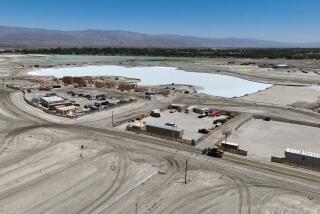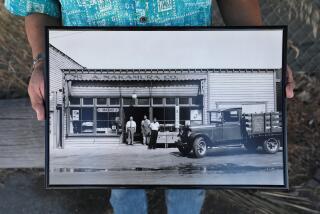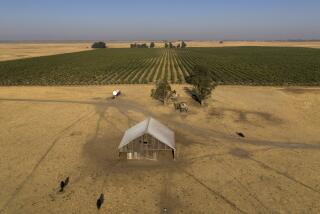Planners See Treasure in Bay’s Island
- Share via
SAN FRANCISCO — Here in one of America’s most densely populated cities, there are more than 15,000 people per square mile. Land values soar as high as skyscrapers. There is little room to grow in any direction except up.
But if all goes as planned, a 20-acre organic farm could be planted within the city’s bursting boundaries -- part of a new open-space preserve a third the size of Golden Gate Park -- alongside up to 5,500 housing units that would make neighbors of formerly homeless people and wealthy condo owners.
The proposed enclave would have spectacular views and rules so stringent that Manhattan would look car-friendly by comparison; local officials are already gushing about “the most environmentally sustainable large development project in U.S. history.”
Large, of course, is in the eye of the beholder.
This winter, after more than a decade of effort, San Francisco officials are unveiling proposals to create what amounts to a self-supporting miniature city on the former Naval Station Treasure Island, a 400-acre island dredged from the bottom of San Francisco Bay.
Although decommissioned military bases often give cities enviable opportunities for development, Treasure Island is a case apart. On the plus side, it is a “flat pancake in the middle of the bay,” said Michael Cohen, the city’s director of base reuse, which makes it “a perfect palette to play out some of these cutting-edge concepts” with no neighbors to offend. On the minus side, well, it’s an island in the middle of the bay. Until a $35-million to $40-million ferry terminal is built, the only way off is the traffic-choked San Francisco-Oakland Bay Bridge. It’s so windy that the U.S. Army Corps of Engineers couldn’t get a single private dredger to bid on a contract to build the island even though work was scarce during the Depression. And it’s really, really small.
On less than two-thirds of a water-ringed square mile, a development team headed by Lennar Corp. is figuring out what amounts to the basic building blocks of smart growth:
How many people are needed to support a grocery store? How many commuters make a ferry line possible? How many rich owners of market-rate housing are required to enable a city to provide affordable homes? Can the bay’s ample sun and whipping winds be harnessed to power homes and businesses? Can food be grown in the middle of a housing development to help feed thousands of new residents?
“On islands, experiments can happen; they’re controllable because they have defined boundaries,” said Eric Antebi, national press secretary for the Sierra Club, who describes Treasure Island as a case study with effects that will go beyond San Francisco’s borders. “It’s rare that a city gets the chance to say ‘If we do it right, what does right look like?’ ”
First envisioned as the site for an airport, Treasure Island was originally built by the Army Corps of Engineers, who dredged 30 million cubic yards of mud, sand and gravel to create the small, flat land mass. Local dredgers stayed away from the project, in part because of “their fear of the weather conditions prevailing on the waters in which the work was to be done,” according to “Engineers at the Golden Gate,” an Army Corps history of the region.
“Their concern was justified,” the history continued, because the area “is indeed subject to severe winter storms as well as heavy wind and wave action during the summer months. As a matter of fact, there are very few months of the year which might be termed favorable for dredging.”
Which raises the question: What is the weather favorable for?
Although the airport never materialized, in 1939 and 1940 the island was the site of the Golden Gate International Exposition, which celebrated the completion of two monumental bridges that span the scenic San Francisco Bay.
When World War II broke out and American military forces began to mobilize, Treasure Island was turned over to the Navy. Although the base was selected for closure in 1993, the military has yet to give San Francisco permanent title to the property, which is a necessary step before development begins. Negotiations between the city and the Navy continue over the terms of the transfer and the routine environmental cleanup.
Today, the island is a motley mix of shuttered military buildings, a just-closed public school and a federal vocational training program. Around 850 units of refurbished Navy housing are rented out, some through a supportive program for the formerly homeless.
There are a few city offices, and some historic buildings. Some film production takes place on the island. A small cafe is open a few hours each day, and disposable cameras are sold from a hut so that bundled-up tourists can capture the panoramic views.
But the weather that kept dredgers at bay does raise questions about whether the winds can be tamed enough to make Treasure Island suitable for condos and crops.
Those involved in the project say the answer is yes. In unveiling its first land-use plans in November and December, the development team described streets mapped to deflect 30-mph gusts, rows of turbines to harness the wind’s energy and help power the island and high-rise residential towers built to shelter street-level activity.
“We used to joke that when we were looking at potential developers, we’d bring them out in the morning, not in the afternoon,” said San Francisco Mayor Gavin Newsom, so they wouldn’t be frightened off by the strong gusts. Newsom said he views weather as a major challenge to developing “one of the great pieces of land in the world.... The exciting thing about the design is how it takes advantage of the wind patterns.”
The developers also have researched what grows well in the rural enclaves that ring the Bay Area, and they acknowledge that weather and soil conditions will definitely affect what can be cultivated on any Treasure Island farm. Early proposals call for crops that include strawberries and lettuces, zucchini and artichokes and a large greenhouse operation for tomatoes and peppers.
“We have some challenges; we don’t have the answer yet to grow edible plants,” said landscape architect Kevin Conger of CMG, whose firm is creating the open-space plan. “Even if we couldn’t do that, we’d still pursue the idea of the farm as horticulture, cut flowers, a nursery site for habitat restoration.”
The biggest question facing Treasure Island is likely to be transportation, and the first concrete plans for addressing cars and congestion will be unveiled this week. But, prodded by local environmentalists, developers have already begun to lay out themes for a community where cars are more annoyance than convenience.
Treasure Island is connected to even tinier Yerba Buena Island, a natural isle once known for the goats that clambered around its rocky peaks. The Bay Bridge links the two small islands to San Francisco and Oakland. At peak commute times, bridge traffic is often at a standstill.
It costs $3 to cross the bridge heading west, but the toll plaza is in Oakland, so Treasure Island’s current residents can drive from their homes to San Francisco and back without paying.
That will probably end after the new development commences. Residents probably will be charged to leave the island during peak commute times through a practice called “congestion management pricing.”
In addition, parking will not be included in the price of a town house, condominium or apartment, and half of the island’s residential parking spaces will be in communal garages a shuttle ride away from homes.
However, the public bus that connects the island to downtown San Francisco will run more frequently, and 80% of Treasure Island housing will be within a 10-minute walk of the ferry terminal.
“We have to be practical as developers, and it’s hard to divorce people from their cars,” acknowledged Kofi Bonner, Lennar Corp. executive vice president. “But we want to make it more difficult to use your car, more inconvenient, more expensive to park ... more expensive to leave the island.”
Environmental advocate Ruth Gravanis has spent nearly a decade prodding planners and city officials to increase open space, density and ferry accessibility and decrease parking. Her mantra: “People need to get it into their head that it’s an island. You leave your car on the mainland.”
But she also worries about fairness on an island that will have 30% affordable housing and accommodations for formerly homeless people alongside pricey town houses and penthouse condominiums.
“One concern is that the bus will be the poor person’s transportation and the ferry will be for the rich people,” Gravanis said. “It is a design challenge, creating community ... the mixing and mingling.”
No one here is underestimating the hurdles that lie ahead, and the project is expected to take 10 to 15 years to complete.
The plans are still in their early stages. Treasure Island could be home to between 10,000 and 15,000 people, although it is unknown how much the planned housing would cost. But Emily Rapaport, a community organizer and co-chairwoman of the island residents’ association, said she worries that the price tag for making the island seismically safe for high-rises could push people like her out.
Although she said she is impressed by many of the proposals, she also wishes that there were more jobs for island dwellers built into the development. “I understand we’re surrounded by water and that they want to use this to have a lot of sport and recreational stuff and businesses that cater to that,” Rapaport said. “ But it seems to me that at some level, this is going to be Disneyland.... I’m not sure that San Francisco needs more of that.”
There are other hurdles. The Navy has to transfer the land. The plans must conform to a complex state law that restricts how public waterfront properties can be used.
The San Francisco Board of Supervisors must give its blessing. And seismic and environmental cleanup issues must be addressed.
Still, “this is an unparalleled opportunity for San Francisco to do something that is really bold,” said Jack Sylvan, Treasure Island project manager for the city. “There are huge challenges. We’re confident we’ll get there. We’ll see what it looks like when we do.”
More to Read
Sign up for Essential California
The most important California stories and recommendations in your inbox every morning.
You may occasionally receive promotional content from the Los Angeles Times.











